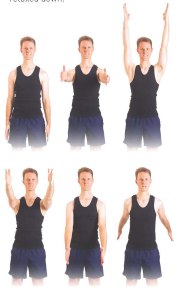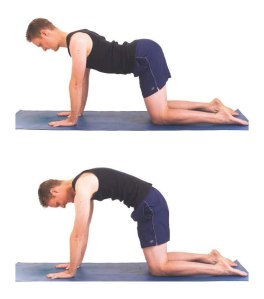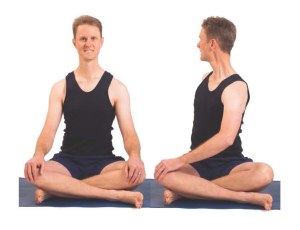Active recovery
After a hard ride you probably feel like complete rest but a bit more low-intensity activity will make you feel better in the long run. Simon Vincett explains.

With the peak riding season upon us, you might as well make the most of your efforts. That’s what active recovery offers, with the added benefit of reducing soreness and stiffness as well. This routine is designed to fit into 30 minutes a day between training rides or events.
Active recovery consists of two phases: action in the hours following a hard effort and action over the days following. The theory is that activating blood flow and the other systems of the body stimulates healing and repair needed after heavy training.
Directly following your hard ride, walk around for five or ten minutes instead of sitting down, do some light stretching and grab a massage if one’s on offer. The idea is to keep the blood following through the muscles you’ve just been using. If possible, plan to ride home from the end of the event or training session—ideally within half an hour of finishing.
In the days following, you want to do low-intensity exercise and stretching or self-massage every day between training efforts. Riding to work is convenient low-intensity exercise if your commute takes you between 20 and 30 minutes. Otherwise you could ride with the kids to school or go for an easy 20 spin outside or on an indoor trainer in your own time.
To understand the intensity you’re aiming for with active recovery, you should feel energised after your session rather than depleted. If you overdo it, you risk burning yourself out from over training. With low-intensity riding you should be able to talk, sing or whistle comfortably without being out of breath.
The theory is that activating blood flow and the other systems of the body stimulates healing and repair needed after heavy training.
A heart rate monitor is an accurate tool to keep your active recovery riding low-intensity. Aim to keep your heart rate at 50 to 70% of your maximum heart rate. An estimate of your maximum heart rate can be calculated as 220 beats per minute minus your age.
On alternate days to your low-intensity rides, some stretching or self-massage will aid your recovery. The stretches suggested here address a few of the common areas of stiffness and soreness that bike riders experience. If you have more stiffness in a particular area, do more of the stretches targeted at that area. For instance, if you get a stiff neck and shoulders from riding, do all these stretches but do twice as many neck rolls, arms swings and thoracic spine movements.
You can also help yourself by taking a walk or doing some light stretching at lunchtime. You might find a hot water bottle or compression tights relieve sore muscles (you can even wear compression tights under your work clothes). Everybody reacts differently to these therapies, so see what works for you.
You also need to schedule rest time. Rest periods are when your muscles consolidate the work done in training. Quality rest includes good sleep, good hydration and good eating. You’re on the training wagon—be good to yourself and you’ll see good results.
Finally, listen to your body. If you’re injured, run-down or menstruating you need to ease off on the training and scale back the active recovery as well—just until you’re ready to bounce back into it.
Stretching
The obvious benefit of stretching is that it relieves muscle stiffness from training. The hidden benefit is that it promotes blood flow and better healing as a result. Do the following stretches slowly and with a few repetitions of each. Try to activate just the muscles targeted and keep the rest of the body still and relaxed.
Neck rolls
The neck can spend a long time in flexion looking forward while riding. It will appreciate a bit of stretching to balance that.
Make sure you extend through the crown of your head while rolling to lengthen the neck. Relax the shoulders down away for the ears and only use the neck muscles.

Arm swings
For bike riding we half-use the flexion motion of the shoulder joint when reaching forward to handlebars and we don’t use the extension motion at all, which can lead to tightness in the shoulders and poor posture.
Roll the shoulders back and down while you lift your arms, extending through the fingertips until the biceps are beside the ears. Reverse this motion and swing the arms slowly back, extending through the fingertips, as far as possible keeping the shoulders relaxed down.

Thoracic spine
The humped back posture of roadies is not a healthy one for life off the bike. Concentrate here on opposite motion by bringing the chest through between the arms and then exaggerate the hump to compensate. Explore the full range of motion.
With knees below hips and hands slightly forward of shoulders, hump the back as high as you can using the whole spine and then concave the back in the opposite direction.

Hamstrings
Using the floor as a reference for a flat back, you can strengthen core muscles while doing this hamstring stretch. Stronger core muscles bring a flat, relaxed lower back to your riding posture.
With finger inter-locked behind your lower leg, gently extend your heel to lengthen the hamstring. Hold for five breaths for each leg.

Lunge
This one stretches the neglected top end of the quad and gives the groin complex of muscles a bit of attention too—both of which are shortened by the repetition of the cycling motion.
Press down through the top of the big toe knuckle on the back foot and bring the front knee over the front ankle. Tuck the hips under slightly as you lunge deeper. Hold for five breaths for each leg.

Cross-legged twist
This is good for releasing tight back muscles and core and supporting muscles too.
Don’t bother about twisting your neck too much—it’s the torso that needs to twist. Use the arms for leverage and roll the back shoulder back to open the chest.

For the best program for your individual needs, see your doctor or a fitness professional.
Ride On content is editorially independent, but is supported financially by members of Bicycle Network. If you enjoy our articles and want to support the future publication of high-quality content, please consider helping out by becoming a member.








I would really like to see you use an ITB roller I use one regularly but would be open to new techniques.
ITB very seriously important to look after too.
Learnt the hard way.
I rode for 60 minutes.on a seat that was too low and injured my ITB.
$200 physio later and lots of stretches and rest 3 months and I was better.
Had to start cycle fitness all over again.
Ta for those excellent suggestions. Will do ronight
Very helpful ideas. Btw, have you got any specific tips for cramp in legs after longer rides?
Hi Andy. Glad this seems helpful. Cramps are really tricky. There’s no consensus on their cause. Gentle stretching is a common treatment found to be effective. For more information, have a look at this page http://www.betterhealth.vic.gov.au/bhcv2/bhcarticles.nsf/pages/Muscle_cramp.
Good advice on active recovery, regular stretching is helpful keep your muscles from tightening up. Must do spinal extension work by lying face down and pushing upper body up like the cobra in yoga. This unloads the bending strains from cycling and important to reduce lumbar disc loading. also stretch calves glteals and thighs. Those muscles do alot of work. Pete a Physio on a bike
It would be useful to know Simon where you are coming from and your expertise: eg are you a physio? I remember someone telling me neck rolls weren’t a good idea and that it was better to use my hand to push against to ensure I didn’t injure my neck…
Hi Amanda. These are general exercises for anyone to do. If you’ve had advice not to do a particular exercise, then you certainly shouldn’t. The exercises are compiled with reference to a myotherapist. For a personal plan, you should consult a fitness professional.
Great article. I (and many of our customers) use an electric bike for recovery riding and base building. Low intensity, you are still riding, and its fun – gets you keen to ride the hard stuff again.